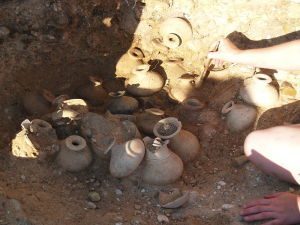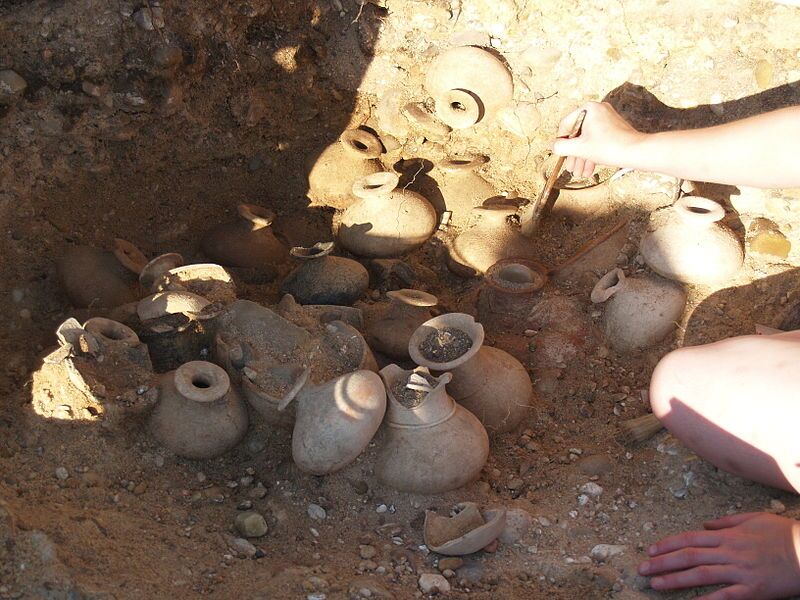
Pintia, Spain—At an archaeological site in north central Spain, an archaeological team has been uncovering prolific finds that testify to a civilization that occupied a region of Spain long before the Romans arrived and conquered. The archaeological area measures about 125 hectares and contains the remains of human occupation spanning more than 1,000 years. Recently, archaeologists have recovered numerous artifacts from 2,500-year-old burials, particularly cremation tombs, that have provided a window on the Vaccean culture, an Iron Age people who lived and thrived in the area for several centuries BC, before the arrival of the Romans.
“It was dominated by three cultures: Vaccean, Roman and Visigoth, although the pre-Roman people, during the final four centuries BC, were the most important for the area,” state Carlos Sanz and colleagues. Sanz is the site director and Professor of Archaeology at the University of Valladolid. “Although most of the archaeological remains are below ground,” he and his colleagues continue, “in the past few years the archaeological team has been excavating and restoring the site to shine light on this distant people.”*
Over the past decade the team has excavated at least 150 cremation tombs containing a variety of grave goods: funerary jars, daggers, necklaces, children’s toys, knives, tongs, iron grills, broaches, and spear points, among other types of artifacts. From these finds and other discoveries in the area, Sanz and his colleagues are slowly developing a knowledge base about the ancient Vaccean culture in the area—a people who believed in an afterlife and lived in a hierarchical society ruled by a small military elite. The overall study site features several different areas of study, including a residential settlement called Las Quintanas, its necropolis called Las Ruedas, the ustrinum or crematorium called Los Cenizales, a possible sanctuary between Los Hoyos and Las Ruedas, and an artisan neighborhood in Pesquera called Carralaceña, which has its own residential area, necropolis and pottery-making facilities. Referring to Las Quintanas, Sanz, et al., state that the “excavation and aerial photography have revealed a well-developed layout with a system of primary and secondary roads. Houses were built of adobe, wood, and mud walls, with straw roofs and floors of compressed earth.”*
_____________________________________________
 The cremation grave shown above was one of the richest Vaccean burials found at Pintia’s necropolis, Las Ruedas. It contained a large number of perfume bottles, among other things. Photograph taken during the June 2008 field school session. Wikimedia Commons
The cremation grave shown above was one of the richest Vaccean burials found at Pintia’s necropolis, Las Ruedas. It contained a large number of perfume bottles, among other things. Photograph taken during the June 2008 field school session. Wikimedia Commons
_____________________________________________
Pintia first came to light in 1870, when local farmers came across bones and artifacts, bringing the discovery to the attention of local authorities. But the most recent organized research in the area didn’t begin until 1979 under the auspices of the University of Valladolid, with a hiatus of two decades and then resumption in recent years with a focus on the Vaccean necropolis.
Sanz and his team will be returning to the site in June and July of 2015. Individuals interested in learning more about the excavations and the Vacceans and how to participate may find more information at the project website.
The excavation field school at the site is carried out through a partnership between the University of Valladolid and ArchaeoSpain.
____________________________________________________________
*http://archaeospain.com/programs/necropolis-of-celtic-iron-age-pintia/
____________________________________________________________
Read about the most fascinating discoveries with a premium subscription to Popular Archaeology Magazine. Find out what Popular Archaeology Magazine is all about. AND MORE:
On the go? Get the smartphone version of Popular Archaeology as an app or as an ebook.
Just released!
The special new premium quality print edition of Popular Archaeology Magazine. A beautiful volume for the coffee table.
Travel and learn with Far Horizons.
____________________________________________
Popular Archaeology’s annual Discovery Edition eBook is a selection of the best stories published in Popular Archaeology Magazine in past issues, with an emphasis on some of the most significant, groundbreaking, or fascinating discoveries in the fields of archaeology and paleoanthropology and related fields. At least some of the articles have been updated or revised specifically for the Discovery edition. We can confidently say that there is no other single issue of an archaeology-related magazine, paper print or online, that contains as much major feature article content as this one. The latest issue, volume 2, has just been released. Go to the Discovery edition page for more information.








